In the world of SEO, understanding the difference between DA and DR is crucial for developing a winning strategy. These two popular metrics—Domain Authority (DA) by Moz and Domain Rating (DR) by Ahrefs—offer insights into a website’s potential to rank in search engines.
Although they are both used to the same end, DA and DR are both distinct in terms of their techniques and requirements, which can greatly determine the way you conduct your link-building activities, assess a competitor, and monitor your website authority as it progresses.
When should you care about DA vs DR?
If you've ever found yourself asking, “what is DA in SEO?” or “what is DR in Ahrefs?” — you're in good company. As websites increasingly compete for higher visibility in Google search results, DA and DR have become essential SEO benchmarks.
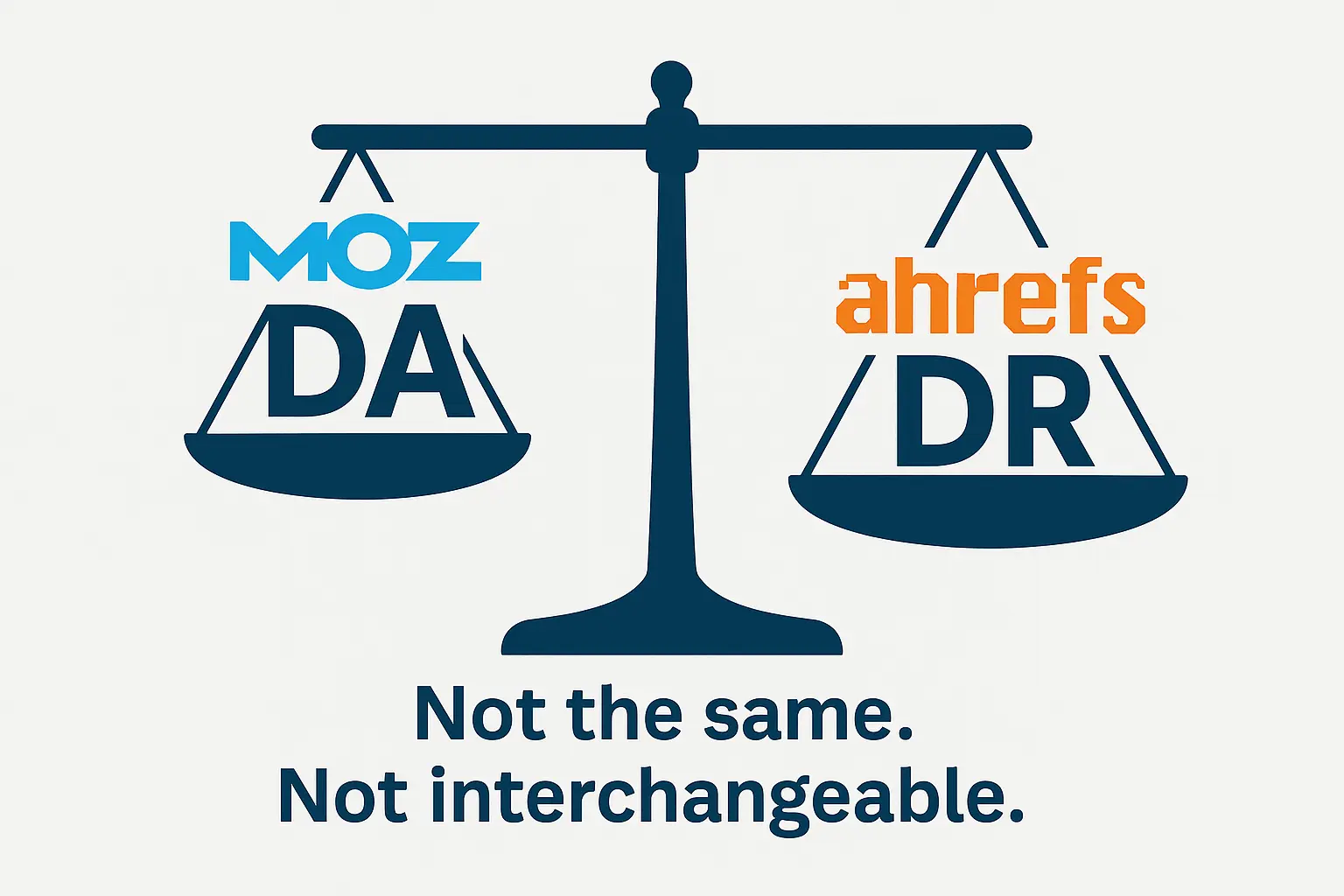
At a glance, these terms might appear interchangeable, but they represent very different concepts. Grasping the differences between domain rating vs domain authority is vital for creating an effective SEO plan and enhancing your site’s search presence.
What is DA in SEO?
Domain Authority (DA) is a proprietary metric developed by Moz. Its primary function is to estimate the likelihood of a website ranking well on search engine result pages (SERPs). DA uses a logarithmic scale from 0 to 100 — the higher the number, the stronger the domain's ability to rank.
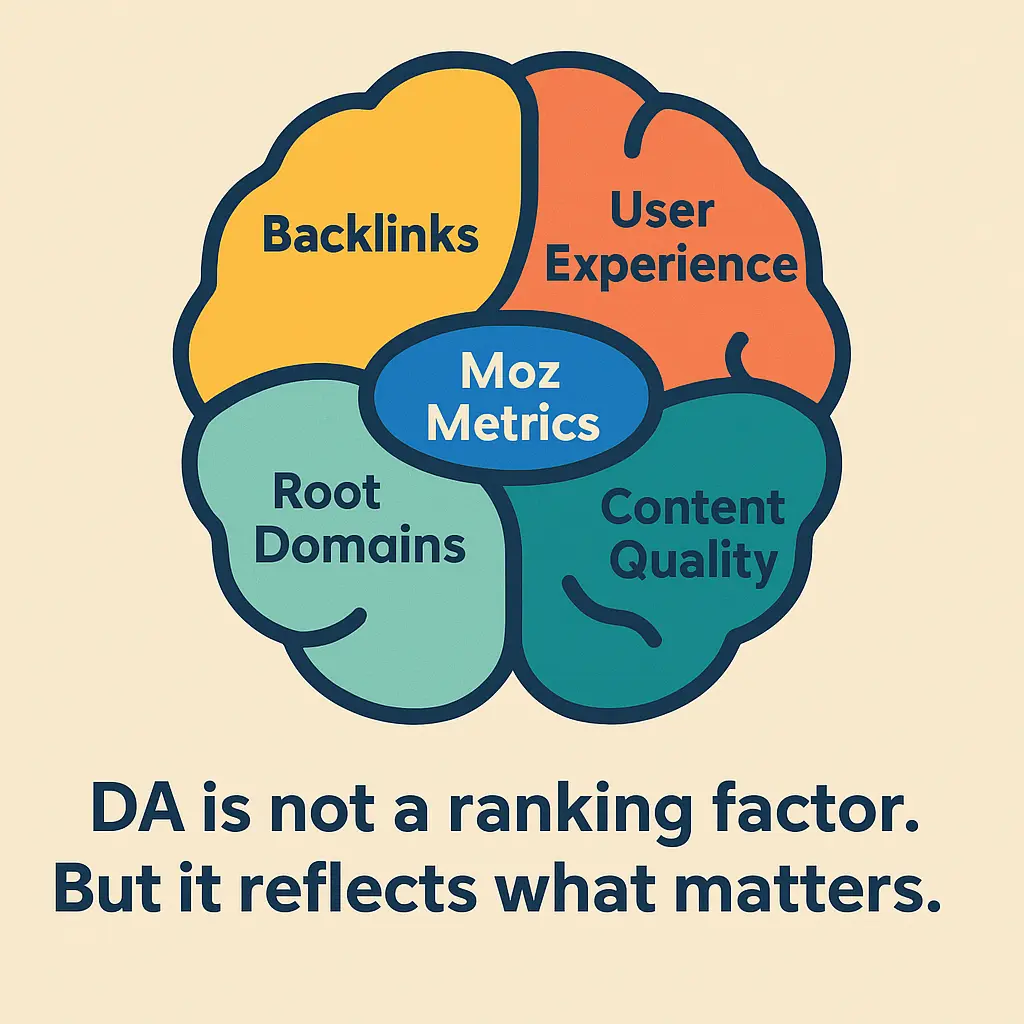
Moz evaluates over 40 key metrics to calculate DA, including the number of linking root domains, the quality of backlinks, the website's overall structure, and the relevance of its content. These inputs are processed using machine learning to generate a final domain authority score. Tools like Moz Link Explorer, MozBar, and domain authority metrics provide this data, typically updated monthly.
It’s important to understand that DA is not a direct ranking factor in Google’s ranking algorithms. However, it reflects many elements that Google does care about — such as authoritative backlinks, solid structure, quality content, and a great user experience. As a result, websites with high DA often receive more organic traffic and perform better in search engine rankings.
What is DR in Ahrefs?
Domain Rating (DR) is a metric introduced by Ahrefs to measure the strength of a website's backlink profile. Like DA, DR ranges from 0 to 100, with higher numbers indicating a stronger dr score and more trustworthy link profile.
What makes DR different is its focus: it measures only off-site signals, especially the number of unique domains linking to your website. It emphasizes anchor text ratios, the volume of inbound links, and the strength of those referring domains.
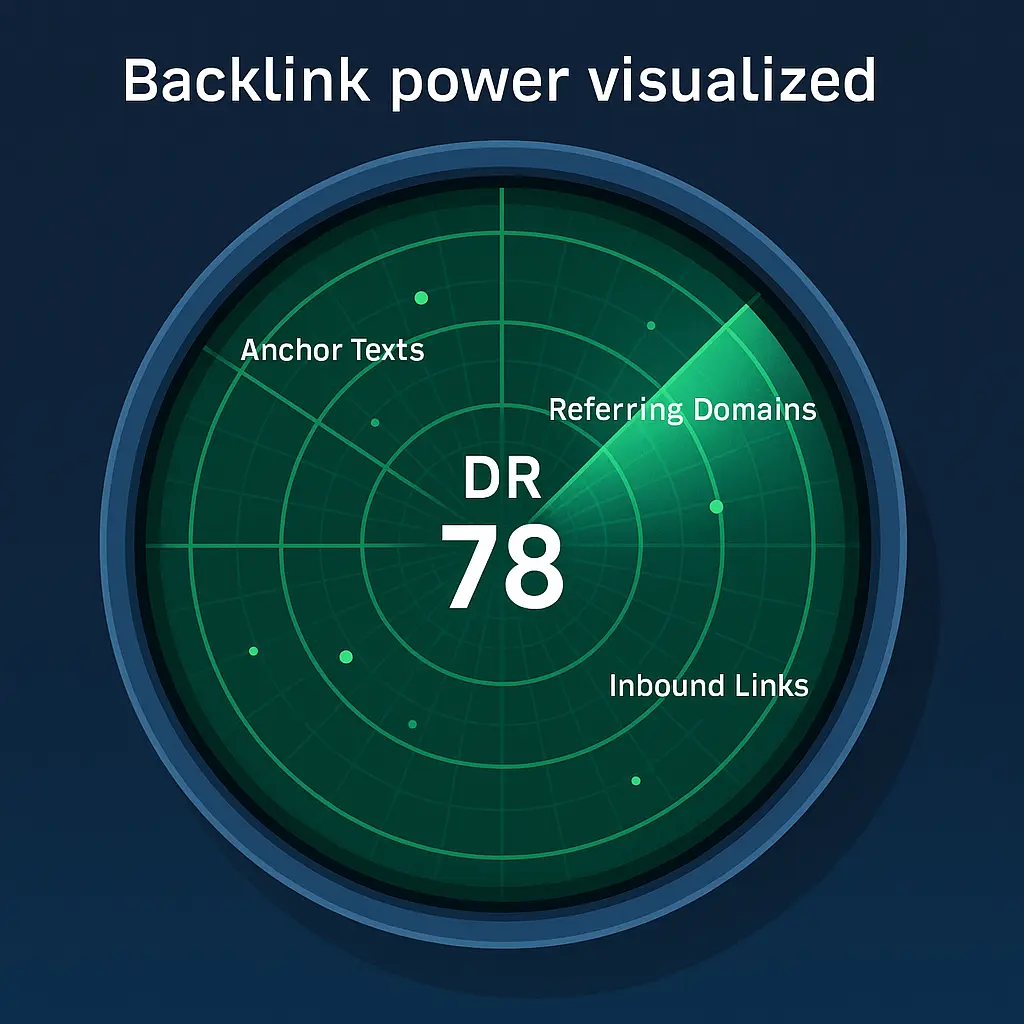
DR is an effective tool for identifying link building opportunities, particularly when analyzing similar sites or competitors in your niche. It’s frequently updated, and Ahrefs displays this metric prominently across tools like Site Explorer and its SEO metrics dashboard.
Looking for more tools like Ahrefs?
Check out the 👉 best Ahrefs alternatives 👈 — find the perfect SEO platform for your business!
Key differences between DA and DR
While DA and DR are both indicators of authority, they differ significantly in methodology and application:
Feature |
Domain Authority (DA) |
Domain Rating (DR) |
|---|---|---|
Developed by |
||
Scale |
0–100 |
0–100 |
Focus |
Overall SEO potential |
External backlink strength |
Data Sources |
Moz Link Explorer, MozBar |
Ahrefs backlink index |
Frequency of Update |
Monthly |
Daily or weekly |
Internal Links |
Not factored in |
Included in scoring |
Calculation Model |
40+ machine-learning-based SEO factors |
Referring domains and their DR |
Best For |
Content planning, SEO benchmarking |
Backlink audits, outreach planning |
This holistic approach helps SEOs and marketers decide when and how to prioritize certain types of content or promotion. DA provides an overview of your own website performance across web pages, while DR helps measure the strength of your external link profile and reputable sites linking to you.
How does Ahrefs DR compare to Moz DA?
These two metrics reflect different views of website’s domain authority. Moz’s DA includes metrics like page authority, internal links, and content structure, offering valuable insights into the quality of a website. Ahrefs’ DR, meanwhile, is narrowly focused on backlinks and external authority.
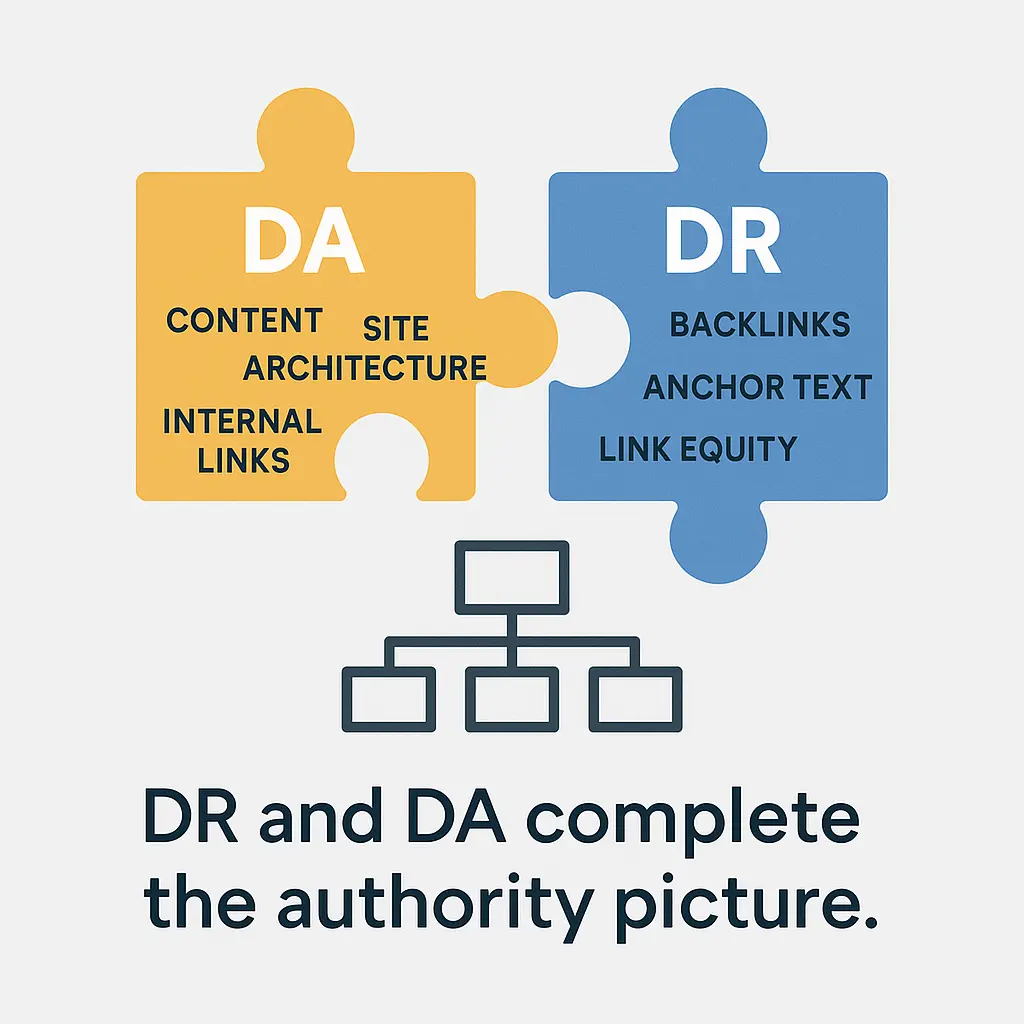
This difference makes DR particularly useful for finding guest posts or understanding why a competitor outranks you based on link-based strength alone. On the other hand, DA allows you to diagnose broader SEO challenges — such as a low DA score despite strong backlinks.
When should you use DR?
DR is especially useful for:
Evaluating potential backlink sources and link acquisition
Discovering gaps in your backlink profile
Benchmarking against competitors in content marketing
Estimating the domain strength of similar sites for outreach
If you’re actively building backlinks or investing in off-site SEO, tracking your DR will give you actionable metrics to improve link equity and drive search traffic.
Not sure which one to choose?
Check out the article 👉 Mangools vs Ahrefs 👈 and choose the best SEO solution for your business in 2025!
When should you use DA?
DA is best suited when:
Planning SEO KPIs for your overall SEO strategy
Auditing multiple pages to assess authority development
Understanding how quality content impacts rankings
Deciding where to improve your blog post strategy and relevant keywords
Tools that provide a free domain authority score are ideal for quick audits, but combining those results with website authority checker insights gives a more accurate picture of your site’s trajectory.
Comparing DA and DR in SEO tools
Using both metrics together with others provides deeper analysis:
SEMrush Authority Score balances traffic and links
Majestic’s Trust Flow and Citation Flow emphasize link trust and volume
PA vs DA and UR vs DR offer comparisons between page-level and domain-level strength
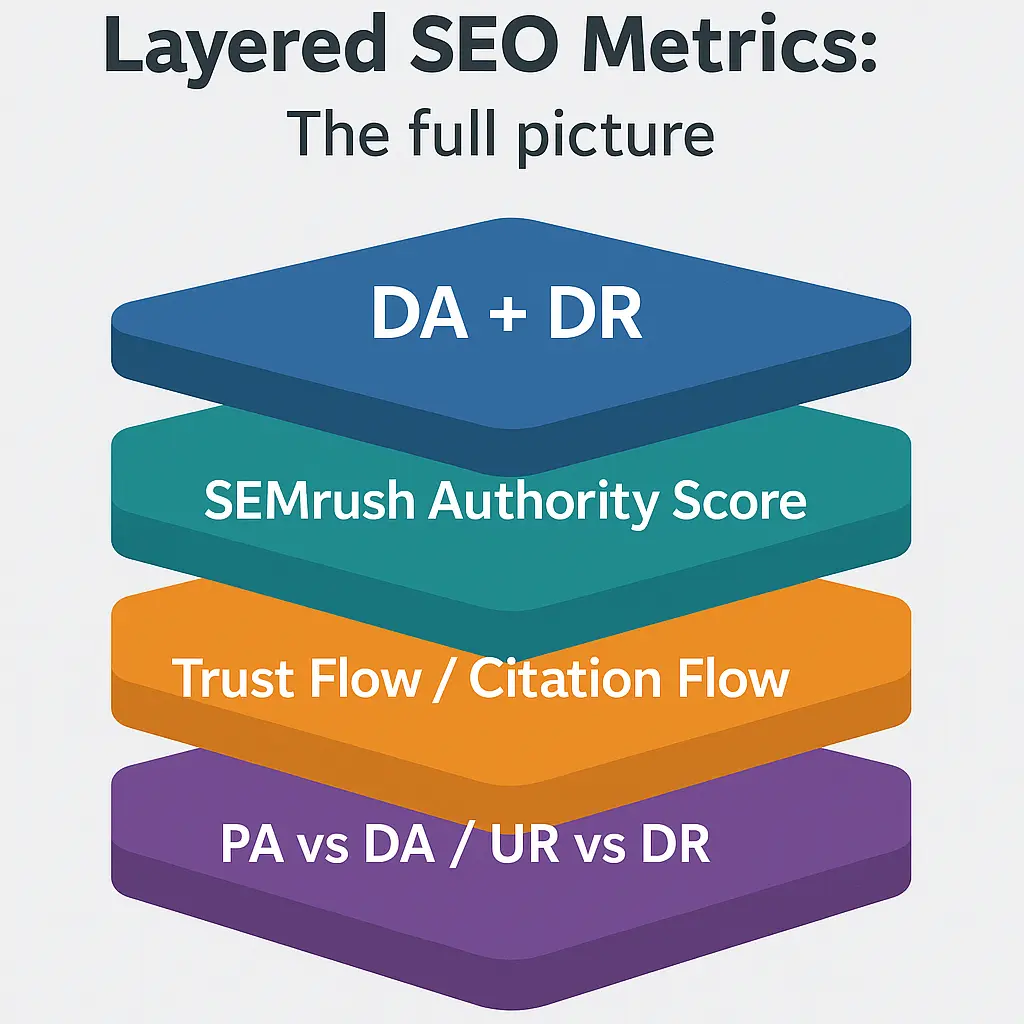
By layering these metrics, you gain a full understanding of how pieces of content influence authority and where to prioritize improvements.
Do Google’s algorithms use DA or DR?
No — DA and DR are not official Google ranking signals. However, they reflect elements of SEO that Google does prioritize, including high-value backlinks, content quality, and domain trust.
Sites with strong DA and DR typically:
Rank for more relevant keywords
Attract more quality backlinks
Gain stronger visibility on Google thanks to reputable sites linking in
That’s the good news: working to improve both DA and DR will almost always align with improving your rankings — even if these scores themselves aren’t part of the algorithm.
Final thoughts: Should you prioritize DA or DR?
DA and DR are not competitors — they serve different purposes, and both are vital in a modern SEO workflow.
DA is excellent for evaluating your own website and planning long-term SEO initiatives across multiple web pages. DR, in contrast, is a tactical tool for discovering link building opportunities, analyzing competitors, and tracking the power of inbound links.
Whether you're improving your da score or monitoring your dr score, using both will support a more strategic, data-driven SEO approach. Publish quality content, build quality backlinks, and target high-impact guest posts — and your domain authority will follow.
You can find even more comparisons and alternatives to very good tools 👉on our blog👈
FAQ
DA (Domain Authority) is a metric by Moz that predicts how well a website might rank in search results, based on factors like internal links, content quality, and overall SEO health.
DR (Domain Rating), created by Ahrefs, focuses only on your backlink profile — specifically, the number and quality of referring domains.
So: DA = broader SEO snapshot, DR = backlink strength only.
It depends on what you're doing.
If you're optimizing content and site structure, DA is more useful.
If you're running a link-building campaign, DR gives better backlink insights.
Smart SEOs track both to get the full picture.
In SEO terms, DA measures the overall potential of your website to rank, while DR shows how strong your backlink game is.
DA considers over 40 SEO factors. DR is more straightforward and link-based.
They serve different purposes but both impact search engine rankings.
Domain Rating (Ahrefs) = backlink strength (external).
Domain Authority (Moz) = ranking potential based on multiple SEO elements (external + internal).
One is laser-focused (DR), the other is more well-rounded (DA).
It’s okay, but not great.
A DA of 20 usually means the site is new or hasn’t built many high-quality backlinks.
If your niche is competitive, aim for DA 40+.
But even DA 20 sites can rank well if your content is solid and keywords are low-competition.
“Dr. DA” isn't an SEO term — probably a mix-up.
But in SEO:
DR = Domain Rating (Ahrefs)
DA = Domain Authority (Moz)
If someone says “Dr. DA,” they likely mean one or both of these metrics.
There’s no official metric called “Dr. ranking.”
But in context, it likely refers to a website’s Domain Rating (DR) score — a number between 0 and 100 that reflects the strength of its backlink profile.
A high DR often correlates with better Google rankings, especially for competitive queries.










